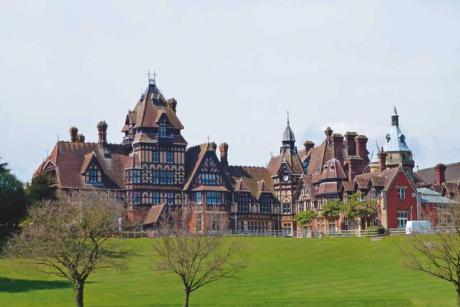
After the disaster of the war with Prussia, the Emperor Napoleon III went into exile in England in 1870, accompanied by his Spanish wife Eugénie and his son the Prince Imperial. They settled at Camden Place in Kent and when Napoleon died in 1873 his wife added a chapel (with memorial) to St Mary’s Roman Catholic Church in Chislehurst, designed by Henry Clutton. In 1879 the prince died fighting with the British army in the “Zulu War” and the following year Eugenie bought the Farnborough Hill estate in Hampshire. It was close to Aldershot, where the Prince had been stationed, and Windsor, conducive to Eugenie’s friendship with Queen Victoria.
This book describes the Farnborough Hill house and its contents. Built in 1860 for publisher Thomas Longman, to the design of HE Kendall Junior, Farnborough Hill is a strikingly showy building of brick and half-timbering,
with fancy gables and turrets. Between 1880 and 1884, Eugénie had it enlarged and redone the interiors in the French style. She also commands a church-mausoleum. The architect was Hippolyte Destailleur (1822-1893), born in Paris, scholar and collector, best known for Waddesdon Manor, Buckinghamshire and for his Collection of prints relating to the ornamentation of apartments in the 16th, 17th and 18th centuries (most of which is now in the Bibliotheque Nationale, Paris).
Architectural historian Anthony Geraghty, a professor at the University of York, gives a detailed account of the house and the remarkable collections it contained. Some of these objects had been attributed to the Empress by the French State, and some had been purchased at the Paris Salon by her and her husband. The collections once adorning the imperial residences of Marly, Saint Cloud and the Tuileries Palace included portraits of François Gérard, Henri-François Riesener, Franz Xaver Winterhalter (including the large painting, Empress surrounded by her ladies-in-waiting), two huge copies of Rubens’ side panels Descent from the Crossformerly in the Tuileries chapel but moved to the transepts of the mausoleum, a series of Gobelins tapestries illustrating scenes from Don Quixote, now in the Virginia Museum of Fine Arts, Richmond and furniture that belonged to Louis XVI and Marie-Antoinette. Among the sculptures was the famous group of the young Prince Imperial with his dog Néron, by Jean-Baptiste Carpeaux.
Eugenie’s desire to keep the house and its contents after her death, which occurred in 1920, was frustrated by lack of endowment, and the family sold most of the contents. Geraghty does his best to report on their current location: many are in French public collections. The generous illustrations record the rooms as they were and are, many of which show the items that once stood there.
He also gives an authoritative analysis of the architecture of the church, which has a dome and an apse, detailing its French models. Eugénie wanted it to be run by a religious community, like a medieval chantry, and the Benedictines are still there. The crypt houses the graves of herself, her husband and her son. Attempts by the French government to return the bodies to France were rebuffed by the monks. The church underwent a brutal reorganization, with the destruction of the original altars and pulpit. However, the closure of St Joseph’s College, Mill Hill led to the installation of four of its altars in Farnborough in 2008, including the high altar by Leonardi of Rome, in marble with inlays. As shown in the illustrations, this could have been mentioned in the book. On the whole, the book is well proofread, which makes it surprising that the architect Mansart appears as Mansard.
Fortunately, the house was purchased in 1927 by the Religious of Christian Education, an order of nuns, to serve as a girls’ school, which survives. They treated it well and made additions which include a chapel by Adrian Gilbert Scott. The book brings to life a forgotten “palace” and its treasures.
• Anthony Geraghty, Empress Eugenie in England: art, architecture, collectingThe Burlington Press/Paul Holberton, 271pp, £40, published September 23, 2022
• Peter Howell was President of the Victorian Society from 1987 to 1993. His latest book is The Arc de Triomphe (Unicorn Edition 2021)
